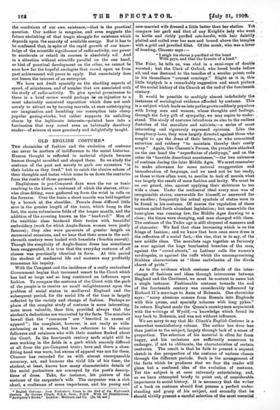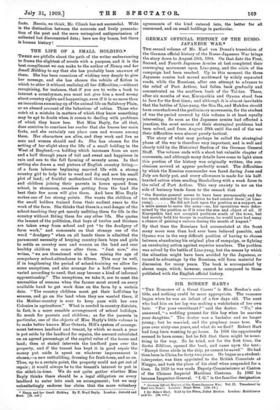OLD ENGLISH COSTUME.*
THE chronicles of fashion and the evolution of costume can never be matters of indifference to the social historian. Human thought is reflected in material objects because human thought moulded and shaped them. So we study the costume of the past not merely to garb our ancestors "in their habits as they lived," but to catch the elusive echoes of their thoughts and tastes which come to us down the centuries from the rustle of those garments.
Englishmen in pre-Conquest days wore the roc or tunic reaching to the knees, a vestment of which the sleeves, other- wise close-fitting, were gathered up from the wrist in rolls on the forearm. Over the tunic a short mantle was held together by a brooch at the shoulder. Female dress differed little save in the greater length of the tunic, which hung to the feet, the more voluminous folds of the longer mantle, and the addition of the covering known as the " head-rail." Men of the wealthier class bordered their tunics with beautiful embroidery (work for which Anglo-Saxon women were justly famous) ; they also wore garments of greater length on ceremonial occasions, and we hear that their arms in the mid- eleventh.century were loaded with bracelets (brachia onerati). Though the simplicity of Anglo-Saxon dress has sometimes been exaggerated, it is true that the everyday costume of all classes was practically identical in form. At this period the student of mediaeval life and manners may profitably commence his inquiry.
With the Conquest and the incidence of a really centralised Government begins that increased resort to the Court which has had so large and so long continued an influence upon fashion. To compare the costume of the Court with the garb of the people is to receive no small enlightenment upon the problem of social status in mediaeval England and the subsequent period, for the social life of the time is largely reflected by the variety and change of fashion. Perhaps no phase of the complex study of costume is more interesting, none more valuable, than this, provided always that the student's deductions are warranted by the facts. The moralists bewail that the " commons " are " besotted in excess of apparel"; the complaint, however, is not really so wide- embracing as it seems, but has reference to the minor followers and retainers who with their masters flocked about the Court. In the fourteenth century serfs might still be seen working in the fields in a garb which scarcely differed at all from the pre-Conquest tunic; here and there a close- fitting hood was worn, but excess of apparel was not for them. Chaucer has recorded for us with almost unsurpassable accuracy, art, and humour the vivid life of his time; the student, at least, knows how many characteristic details of the social portraiture are conveyed by the poet's descrip- tions of dress. Take, for instance, his picture of the costume of the carpenter's wife. The carpenter• was a rich churl, a craftsman of some importance, and his young and
• English Costume : from Prehistoric Times to the End of the Eighteenth Century. By George Clinch, F.S.A. Scot., F.G.S. With 131 Lluatratior.s.
• 'Antiquary's Books." London : Methuen and Co. [7a. 6d. net ]
new-married wife dressed a little better than her station. Yet compare her garb and that of any Knight's lady who went in kirtle and richly purfled cote-hardie, with hair daintily . plaited and coiled over• her ears and bound above the, temples with a gold and jewelled fillet. Of the monk, who was a lover of hunting, Chaucer says:- " I neigh his sieves y-purfiled at the bond
With grys, and that the fyneste of a load."
The Friar, he tells us, was clad in a semi-cope of double worsted ; but the Clerk of Oxford, who loved books before all, and was destined to the benefice of a secular priest, rode in his threadbare " overeat courtepy." Slight as it is, this little triptych is a remarkably suggestive and exact picture , of the social history of the Church at the end of the fourteenth century.
It would be possible to multiply almost indefinitely the instances of sociological evidence afforded by costume. This is a subject which leads us into paths grown suddenly populous with living men and women, whose thoughts and feelings, . through the fairy gift of sympathy, ve may aspire to under- stand. The study of costume introduces us also to the endless diatribes of the moralists and satirists,—a series of most interesting and vigorously expressed opinions. Like the Sumptuary-laws, they were largely directed against those who sought to ape the dress of their betters, or who committed extortion and robbery " to maintain thereby their costly array." Again, like Chaucer's Parson, the preachers attacked on the one hand the " superfluitee of clothynge," and on the other its "horrible disordinat scantnesse,"—the two extremes of costume during the later Middle Ages. We must remember to make allowance for some natural exaggeration and immoderation of language, and we need not be too ready, as those writers often were, to ascribe to lack of morals what was largely the result of mere fashion and levity. We must be on our guard, also, against applying their strictures to too wide a class. Under the mediaeval ideal every man was of recognisable status, answerable for himself, or answered for by another; frequently the actual symbols of status were to be found in his costume. Of course the regulation of these matters called forth abundant legislation; but meanwhile the hour-glass was running low, the Middle Ages drawing to a close ; the times were changing, and man changed with them. The costume of the Tudor age is still eloquent of manners and of character. We find that class increasing which is on the fringe of fashion ; and we know that here once more dress is the reflection of a social fact,—the rise, that is to say, of the new middle class. The moralists rage together as furiously as ever against the huge bombasted breeches of the men, against the " round-abouts," as Latimer calls the women's vardingales, or against the ruffs which the uncompromising Stubbes characterises as " these cartwheelea of the divels charet of pride."
As to the evidence which costume affords of the inter- change of fashions and .ideas through intercourse between England and the Continent, we must be content to name but a single instance. Fashionable costume towards the end of the fourteenth century was considerably influenced by Richard II.'s marriage to Anne of Bohemia. One chronicler says : " mony abusions comme from Boemia into Englonde with this qwene, and , specially schoone with long pykes." In return England made the Queen's countrymen acquainted with the writings of Wyclif,—a knowledge which found its way back to Boheinia, and was not without influence..
We are sorry to say that Mr. Clinch's English Costume is a somewhat unsatisfactory volume. The author has done less than justice to the subject, largely through lack of a sense of proportion. The selection of his material is often far from happy, and his omissions are sufficiently numerous to endanger, if not to obliterate, the characteristics of certain centuries. The result is that he fails to present a sequent sketch in due perspective of the costume of various classes through the different periods. Such is the arrangement of the facts which he produces that we fear the reader will glean but a confused idea of the evolution of costume. Yet the subject is at once extremely entertaining, and, as we have attempted briefly to point out, of considerable importance to social history. It is necessary that the writer of a book on costume should first possess a perfect under- standing and graiip of his subject, and secondly that he should vividly present a careful selection of the most essential
facts. Herein, we think, Mr. Clinch has not succeeded. Wide is the distinction between the accurate and lively presenta- tion of the past and the mere uninspired antiquarianism of collected but disconnected data; here are dry bones, but there is human history!







































 Previous page
Previous page